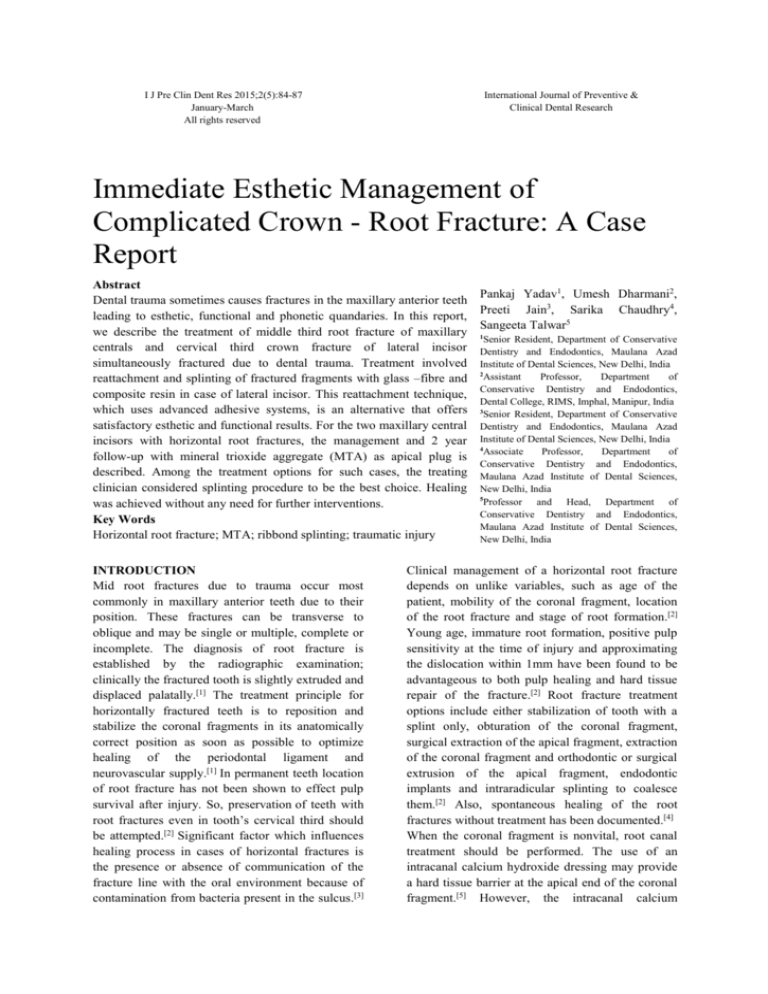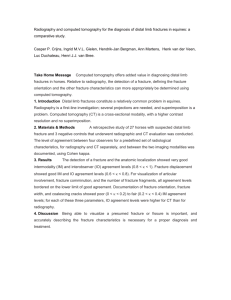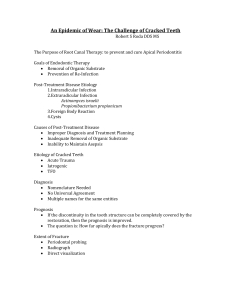
I J Pre Clin Dent Res 2015;2(5):84-87
January-March
All rights reserved
International Journal of Preventive &
Clinical Dental Research
Immediate Esthetic Management of
Complicated Crown - Root Fracture: A Case
Report
Abstract
Dental trauma sometimes causes fractures in the maxillary anterior teeth
leading to esthetic, functional and phonetic quandaries. In this report,
we describe the treatment of middle third root fracture of maxillary
centrals and cervical third crown fracture of lateral incisor
simultaneously fractured due to dental trauma. Treatment involved
reattachment and splinting of fractured fragments with glass –fibre and
composite resin in case of lateral incisor. This reattachment technique,
which uses advanced adhesive systems, is an alternative that offers
satisfactory esthetic and functional results. For the two maxillary central
incisors with horizontal root fractures, the management and 2 year
follow-up with mineral trioxide aggregate (MTA) as apical plug is
described. Among the treatment options for such cases, the treating
clinician considered splinting procedure to be the best choice. Healing
was achieved without any need for further interventions.
Key Words
Horizontal root fracture; MTA; ribbond splinting; traumatic injury
INTRODUCTION
Mid root fractures due to trauma occur most
commonly in maxillary anterior teeth due to their
position. These fractures can be transverse to
oblique and may be single or multiple, complete or
incomplete. The diagnosis of root fracture is
established by the radiographic examination;
clinically the fractured tooth is slightly extruded and
displaced palatally.[1] The treatment principle for
horizontally fractured teeth is to reposition and
stabilize the coronal fragments in its anatomically
correct position as soon as possible to optimize
healing of the periodontal ligament and
neurovascular supply.[1] In permanent teeth location
of root fracture has not been shown to effect pulp
survival after injury. So, preservation of teeth with
root fractures even in tooth’s cervical third should
be attempted.[2] Significant factor which influences
healing process in cases of horizontal fractures is
the presence or absence of communication of the
fracture line with the oral environment because of
contamination from bacteria present in the sulcus.[3]
Pankaj Yadav1, Umesh Dharmani2,
Preeti Jain3, Sarika Chaudhry4,
Sangeeta Talwar5
1
Senior Resident, Department of Conservative
Dentistry and Endodontics, Maulana Azad
Institute of Dental Sciences, New Delhi, India
2
Assistant
Professor,
Department
of
Conservative Dentistry and Endodontics,
Dental College, RIMS, Imphal, Manipur, India
3
Senior Resident, Department of Conservative
Dentistry and Endodontics, Maulana Azad
Institute of Dental Sciences, New Delhi, India
4
Associate
Professor,
Department
of
Conservative Dentistry and Endodontics,
Maulana Azad Institute of Dental Sciences,
New Delhi, India
5
Professor and Head, Department of
Conservative Dentistry and Endodontics,
Maulana Azad Institute of Dental Sciences,
New Delhi, India
Clinical management of a horizontal root fracture
depends on unlike variables, such as age of the
patient, mobility of the coronal fragment, location
of the root fracture and stage of root formation.[2]
Young age, immature root formation, positive pulp
sensitivity at the time of injury and approximating
the dislocation within 1mm have been found to be
advantageous to both pulp healing and hard tissue
repair of the fracture.[2] Root fracture treatment
options include either stabilization of tooth with a
splint only, obturation of the coronal fragment,
surgical extraction of the apical fragment, extraction
of the coronal fragment and orthodontic or surgical
extrusion of the apical fragment, endodontic
implants and intraradicular splinting to coalesce
them.[2] Also, spontaneous healing of the root
fractures without treatment has been documented.[4]
When the coronal fragment is nonvital, root canal
treatment should be performed. The use of an
intracanal calcium hydroxide dressing may provide
a hard tissue barrier at the apical end of the coronal
fragment.[5] However, the intracanal calcium
85
Management of crown - root fracture
Fig. 1: Fractured Crown of Maxillary Right
Lateral Incisor
Yadav P, Dharmani U, Jain P, Chaudhry S, Talwar S
Fig. 2: Radiograph of 11 and 21 showing
fracture line and periapical status
and cross bite
Fig. 3: Clinical Picture Showing wire splint
Fig. 4: Radiograph of 11 and 21 showing
MTA in the fracture line and canal obturation
Fig. 5: Clinical picture showing Ribbond
splint after crown fabrication
Fig. 6: Clinical picture after Ribbond removal
Fig. 7: Radiograph after 24 months
hydroxide dressing requires a long treatment time
and this application needs periodic changes of the
material. Mineral trioxide aggregate (MTA) has
been shown to be very effective in sealing the
pathways of communication between the root canal
system and the external surface of the tooth.[6] It has
several potential clinical applications owing to its
superior sealing property and biocompatibility.[7]
MTA has been recommended and also used
successfully in teeth with necrotic pulp with open
apices.[6] The aim of this article is to report
successful management of mid root fracture with
MTA. The fractured maxillary teeth were
successfully brought to an acceptable immediate
esthetics using ribbond splinting material.
CASE REPORT
A 17 year old boy presented with the chief
complaint of mobile and deranged maxillary central
incisors, maxillary right lateral incisor. The patient
was in good health with no abnormal medical
abnormalities. Extraoral examination showed a
balanced facial pattern. Intraoral examination
revealed lingually displaced and extruded maxillary
central incisors (Fig. 1), cervical third crown
fracture of maxillary right lateral incisor and
cervical third oblique fracture of mandibular right
central incisor. Mandibular incisor fracture line was
oblique, elongating in apical direction from labial to
lingual surface. All the effected teeth had grade II
86
Management of crown - root fracture
mobility. The patient had a history of trauma one
day back. Pulp test of the involved teeth was non
responsive and sensitive to percussion. A
radiographic examination showed middle third
horizontal root fracture of the maxillary central
incisors, cervical third crown fracture of maxillary
lateral incisor (Fig. 2).
Treatment Plan
Treatment objective included restoring the normal
esthetic appearance of maxillary and mandibular
anterior region. Various treatment options were
presented to the patient with their advantages and
disadvantages, including: 1) extraction of the
traumatized maxillary central incisors and
replacement with prosthesis; 2) root canal treatment
of coronal and apical segments (if segments are not
seperated); 3) placement of endodontic implant with
or without periapical surgery; 4) root canal
treatment of coronal segment only. Of the various
treatment options explained to the patient, he
preferred to retain his natural teeth as he was very
apprehensive about his fractured teeth. He was
assured and the condition was explicated to the
patient.
Treatment Method
The treatment implemented was immediate
repositioning of displaced teeth by digital
manipulation. Position of reduced segments was
checked radiographically. Following reduction, a
steel wire passive splint (Fig. 3) was applied to teeth
with flowable light cure composite (Ivoclar
Vivadent, Bendererstrasse Liechtenstein) for a
period of 4 weeks to ensure hard tissue
consolidation. Endodontic treatment was carried
out, the access cavity was prepared ideally, the
contaminated canal remnants were removed and the
working length was obtained. The root canal was
instrumented to the fault line for maxillary central
incisors with size 60 K-file (Dentsply-Maillefer,
Ballaigues, Switzerland) using a step-back
technique. During the instrumentation, the canal
was irrigated with normal saline after each
instrument and 2% chlorhexidine gluconate
(Klorhex; Drogsan, Ankara, Turkey). The canals
were dried with sterile paper points (Diadent,
Chongiu City, Korea). Initially a paste of calcium
hydroxide was packed into the canals to the fracture
lines. The coronal access was sealed with zincoxide
eugenol cement. After one week the teeth were
reinstrumented, the intracanal dressings were
removed and the fracture lines plugged with
ProRoot MTA (Dentsply Tulsa Dental). MTA was
Yadav P, Dharmani U, Jain P, Chaudhry S, Talwar S
mixed in a 3:1 proportion and taken to the fracture
line with a plugger and condensed with a large
reverse gutta percha point. Radiograph was taken to
ensure control of the filling. After MTA placement
the root canal was left with a cotton pellet
moistened with distilled water for 24 hours. After
24 hours the cotton pellets were taken out and the
teeth were obturated with gutta percha and AH Plus
(De Trey Dentsply). The access cavities were
restored with Filtek Z250 composite resin (3MEspe). For Maxillary right lateral incisor access was
prepared after stabilizing the crown by bonding with
flowable composite. Canal was instrumented with
hand K files using a step-back technique and
subsequently obturated with gutta percha and AH
Plus sealer (Fig. 4). Post space was prepared and a
fiber post (Para Post® Taper Lux™, Coltene
Whaldent, USA) was tried in and was bonded to the
tooth utilizing an etchant, primer, adhesive and resin
composite technique. A total-etch bonding agent
(Adper™ Single Bond 2, 3M ESPE, USA) was
applied to the canal. The post and the canal were
coated with resin-based cement (Rely X™ ARC,
3M ESPE, USA) and post was cemented in the
canal. The Fiber post further reinforced coronal
fragment in its anatomic position. After 2 weeks
wire splint was removed, lateral incisor was
prepared for crown and a crown was cemented. A
labial fiber reinforced composite (Ribbond®,
Ribbond Inc., USA) was done after cementation of
crown (Fig. 5). Root canal treatment followed by
post placement and crown fabrication was done for
mandibular central incisor. Short term follow up for
both of the cases showed promising results (Fig. 6).
Patient was comfortable and no periapical
pathology had developed. Twenty four month recall
radiograph showed complete healing between the
fragments (Fig. 7).
DISCUSSION
Facial trauma that results in fractured, displaced or
lost teeth can have paramount negative functional,
esthetic and psychological effects on patients. Quick
restoration of the esthetic appearance and relief of
discomfort may lead to a positive emotional and
social response from the patient. Since the patient
had high level of esthetic demand, an attempt to
preserve the tooth was chosen. The technique
described in the present case report is simple,
expeditious and economic compared with other
more invasive procedures. Root fracture involves
the pulp, dentin, cementum and the periodontal
ligament. Intra-alveolar root fractures occur less
87
Management of crown - root fracture
frequently compared with other dental injuries and
account for probably less than 3% of all dental
traumas.[8] When pulp necrosis arises, the apical part
of the fractured tooth generally remains vital.
Therefore, root canal therapy is applied only to the
coronal fragment, but it is arduous to seal the
coronal part, because an apical stop is often
infeasible to achieve.[9] The initial treatment for root
fracture consists of repositioning the coronal
segment and then stabilizing the tooth to allow
healing of the periodontal ligament supporting the
coronal segment. It is recommended that when the
coronal segment has been luxated, the treatment
should be semi-rigid stabilization for a few weeks.[8]
Rejuvenating in teeth with horizontal fracture is
with one of these types: rejuvenating with hard
tissue, interposition of connective tissue,
interposition of bone and connective tissue and
interposition of granulation tissue. While the first
three types are considered auspicious and the
‘healing with hard tissue’ is the most desired, the
last one represents inflammatory state and is
unpropitious.[10] With the materials available today,
in conjunction with a congruous technique, esthetic
results can be achieved with prognosticable
outcomes.
CONCLUSION
In this case treatment of horizontal root fractured
tooth was carried out with MTA plug and Gutta
Percha obturation. Ribbond splint was used to
provide esthetic. Availability of bondable material,
like fiber posts and MTA have put forth varied
treatment options for clinicians in the management
of mid root fractures. The final result is a
conservative restoration that required little time to
complete.
REFERENCES
1. Andreasen JO, Andreasen FM, Mejare I, Cvek
M. Healing of 400 intra-alveolar root fractures.
Effect of treatment factors such as treatment
delay, repositioning, splinting type and period
of antibiotics. Dental Traumatol 2004;20:20311.
2. Andreasen JO, Andreasen FM, Mejare I, Cvek
M. Healing of 400 intra-alveolar root ractures.
Effect of preinjury and injury factors such as
sex, age, stage of root development, fracture
type, location of fracture and severity of
dislocation. Dent Traumatol 2004;20:192-202.
3. Hovland EJ. Horizontal root fractures. Dent
Clin North Am. 1992;36:509-25.
Yadav P, Dharmani U, Jain P, Chaudhry S, Talwar S
4.
Ozbek M, Serper A, Calt S. Repair of
untreated horizontal root fracture: a case
report. Dent Traumatol 2003;19:296-7.
5. Rafter M. Apexification: a review. Dent
Traumatol 2005;21:1-8.
6. Torabinejad M, Chivian N. Clinical
applications of mineral trioxide aggregate. J
Endod 1999;25:197-205.
7. Holland R, Mazuqueli L, de Souza V, Murata
SS, Dezan Júnior E, Suzuki P. Influence of the
type of vehicle and limit of obturation on
apical and periapical tissue response in dogs’
teeth after root canal filling with mineral
trioxide aggregate. J Endod 2007;33:693-7.
8. Bakland LK. Endodontic considerations in
dental trauma. In; Ingle JI, Bakland LK,
editors. Endodontics. 5th edn. London: BC
Decker Inc.; 2002, p.811.
9. Yildirim T, Gencoglu N. Use of mineral
trioxide aggregate in the treatment of
horizontal root fractures with a 5-year followup: report of a case. J Endod 2009;35:292-5.
10. Kocak S, Cinar S, Kocak MM, Kayaoglu G.
Intraradicular splinting with endodontic
instrument of horizontal root fracture-Case
report. Dental traumatology. 2008;24:578-80.








